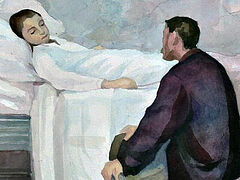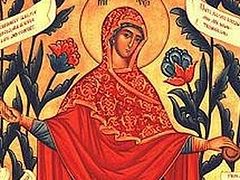 Joy of All Who Sorrow Icon of the Mother of God. Photo: Yuri Gripas
Joy of All Who Sorrow Icon of the Mother of God. Photo: Yuri Gripas
My car had broken down and I couldn’t get to church to greet the Joy of All Who Sorrow Icon of the Mother of God. Feeling dejected, I was watching the Liturgy online from our St. John the Baptist Cathedral in Washington, and I wondered why the Lord allowed this to happen to me: After all, it’s my icon, it’s celebrated on my birthday. But when Metropolitan Nicholas (Olkhovsky), the First Hierarch of the Russian Church Abroad, who brought the icon, started talking about the wonderworking icon, it cleared something up in my mind. After all, I was planning to go to the other service, and then I wouldn’t have watched this one or heard the wonderful story told by the Metropolitan.
This is what Vladyka Nicholas said:
We didn’t particularly plan it, it’s out of our hands, but I believe it’s providential that this sacred treasure—the Joy of All Who Sorrow Icon of the Mother of God—is visiting our church. We brought it from the Synod of Bishops in New York. It’s a wonderworking, beautiful, salvific icon, full of prayer. The Mother of God loves us and has come to strengthen our faith as well.
The icon has its own history. In 1920, Bishop Nestor (Anisimov) opened a shelter for children, orphans, and the sick and the elderly in Harbin, and there he built a church in honor of the Joy of All Who Sorrow Mother of God. One Orthodox woman heard about it and presented Vladyka Nestor with this icon for the church. It was completely dark—nothing could be seen on it.
Time passed, and during one service, the priest noticed that the icon had begun to renew itself somewhat. It went on for an hour, two, three, and he watched. In a short period of time, less than a day, the icon completely renewed itself, and everyone saw the most pure face of the Mother of God, this wonderful image.
 Metropolitan Philaret (Voznesensky)
Metropolitan Philaret (Voznesensky)
Then the icon wound up in Europe, and the ever-memorable Metropolitan Philaret (Voznesensky), who himself served as an archimandrite in Harbin, was able to bring it to New York. Since 1965, this sacred icon has been kept in the lower Church of St. Sergius of Radonezh in our Synod of Bishops. The icon doesn’t go anywhere; it’s always there, and you can come and pray before it.
And here we have such a wonderful miracle. It was out of our hands; it came from above: The icon is visiting us. We can look at it, and moreover, we can pray and understand that we also have darkness, blindness, and just sin inside us. But with prayer, with repentance, we can purify ourselves and remain God-enlightened Orthodox Christians. As the icon has renewed itself, so we can also renew our soul, heart, and mind, our whole life. I urge you all to strive for this.
 Metropolitan Nicholas and Archpriest Victor Potapov. Photo: Yuri Gripas
Metropolitan Nicholas and Archpriest Victor Potapov. Photo: Yuri Gripas
Having heard this story, I decided to ask Archpriest Seraphim Gan, chancellor of the Synod of Bishop of the Russian Orthodox Church Abroad, why this icon, which is usually kept in New York, suddenly came to us so unexpectedly.
“Vladyka decided to bring the icon to comfort and strengthen the Washington flock, which, like everyone else, is fasting for Holy Week and Christ’s Pascha,” Fr. Seraphim told me.
Then Batiushka, whose grandfather, the well-known Archpriest Rostislav Gan, also served in Harbin, added some details to the story. According to him, the icon renewed itself in the 1930s, right in front of people praying at the Liturgy in the Church of the House of Mercy founded by Vladyka Nestor.
 The Kamchatka representation in Harbin, 1930s. Source: Korostelyov, V. V., Orthodoxy in Manchuria, 1898-1956: Essays on History. Moscow: 2019, p. 195
The Kamchatka representation in Harbin, 1930s. Source: Korostelyov, V. V., Orthodoxy in Manchuria, 1898-1956: Essays on History. Moscow: 2019, p. 195
The House of Mercy was considered a representation of the Kamchatka mission, which Vladyka Nestor headed before the revolution and which he hoped to return to. Fr. Seraphim recalled that the brotherhood of the podvoriye included future hierarchs of the Russian Church Abroad, namely Metropolitan Philaret (Voznesensky) and Archbishop Nathaniel (Lvov).
“It’s interesting to note that at that time in Harbin, as in other cities of China where Russian emigrants lived, the miraculous renewal of holy icons and even frescoes in churches was happening,” said Fr. Seraphim. “These miracles strengthened the faith of the emigrants, who were experiencing all kinds of difficulties at that time. And now this icon reminds us that Heaven doesn’t abandon us, that prayer draws God’s mercy to us.”
I was already planning to write this article, but something kept making me put it off. It was planned that the icon would be going back to New York. But it turns out my story was not over yet. A few days later, I made it to our church, for another service; I wasn’t even thinking about it. I quickly venerated the icon in the center and suddenly froze in my tracks: Right before me was the Joy of All Who Sorrow Icon, the very one from Harbin, which was supposed to already be back in New York! “Mother of God, you waited for me. Thank you!” flashed through my mind.
And now I’m thinking that maybe the Lord and His Mother deliberately made it so I “unexpectedly” wound up in church on a different day, to give me such a gift and show that they love me?



